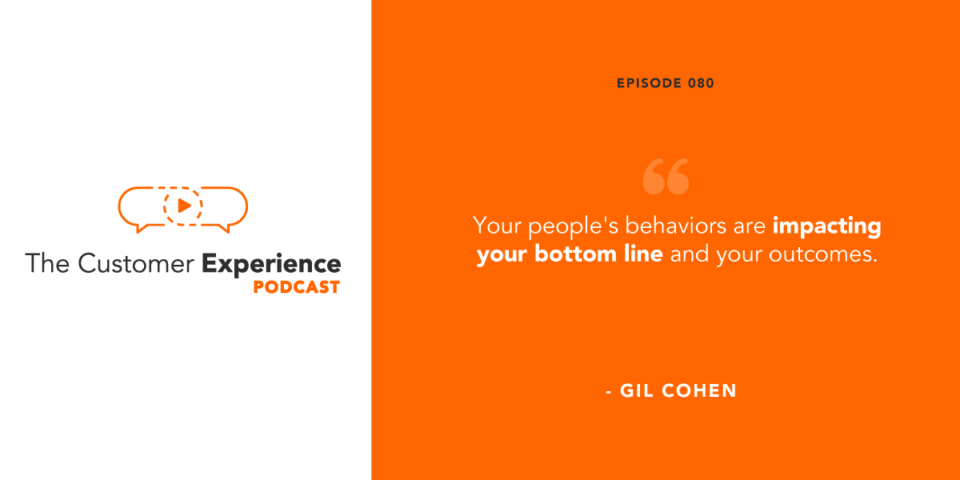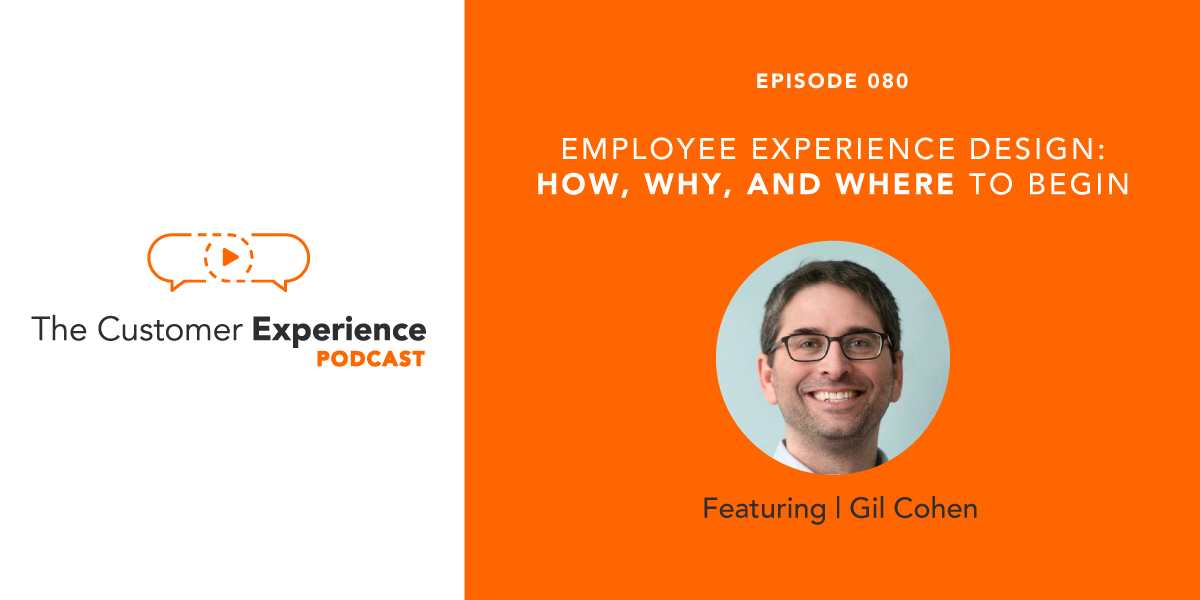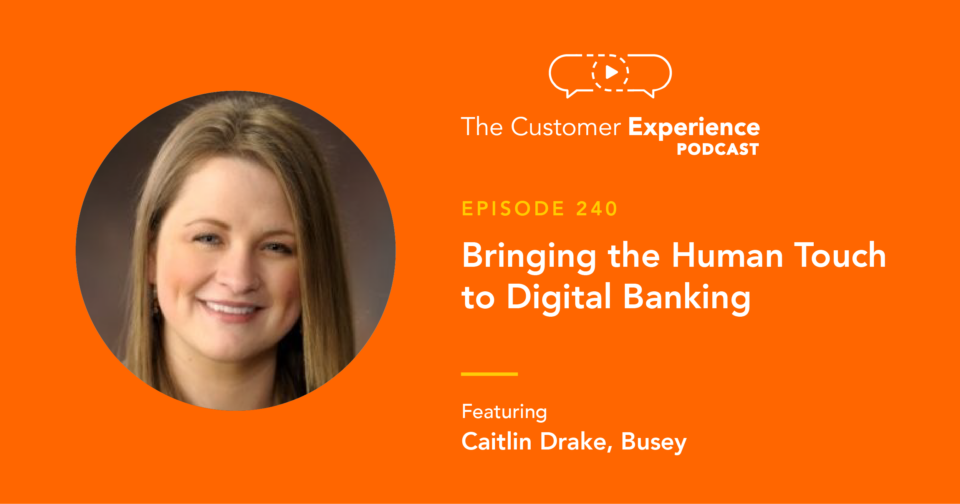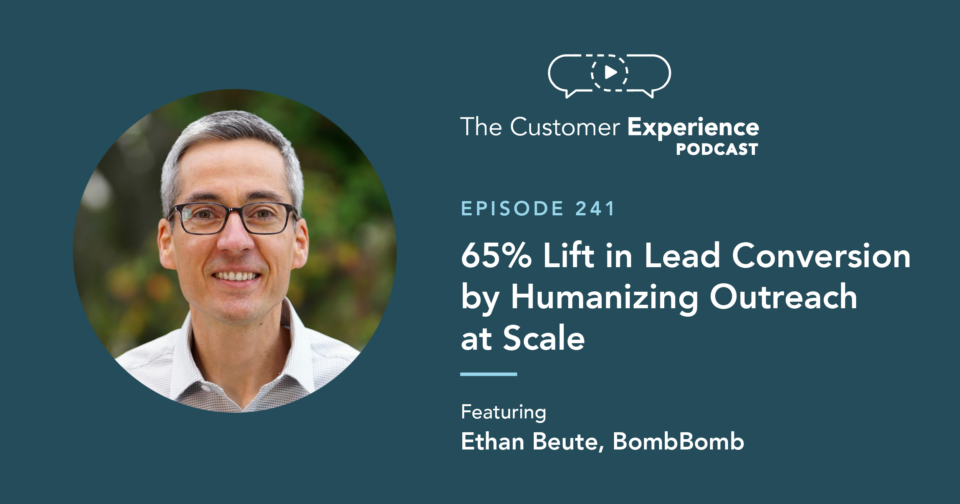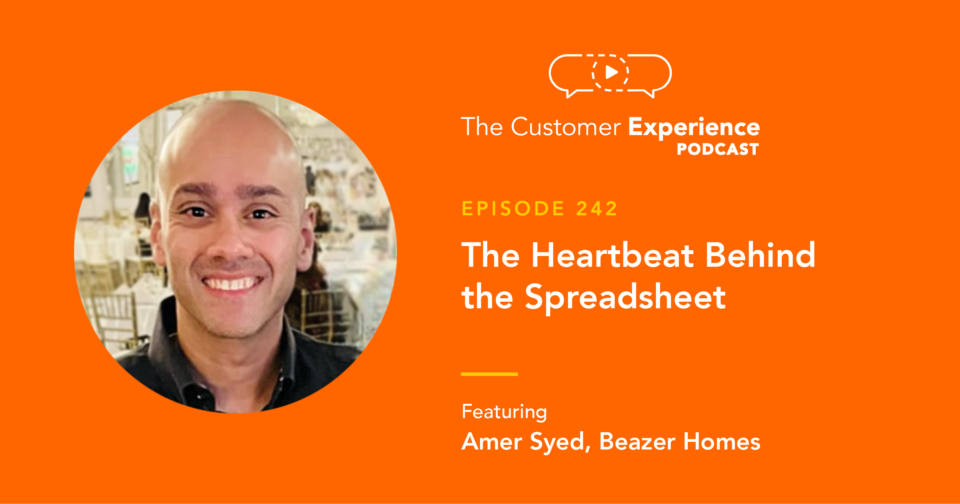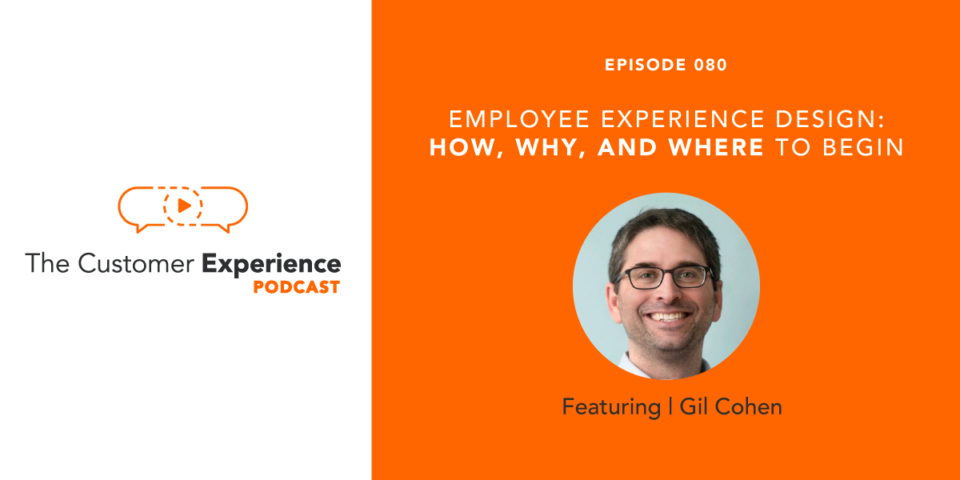
Listen to “80. Employee Experience Design: How, Why, and Where To Begin w/ Gil Cohen” on Spreaker.
Apple Podcasts | Google Podcasts | Stitcher | Spotify
What is your employee experience really like? How do your employees feel about their managers, roles, and work?
Of course, your employees are on the forefront of your business delivering the customer experience. So, if they’re not happy, odds are that your customers aren’t either. If their experience is unremarkable, so is your customer experience.
Shockingly, though, 40% of managers not even checked in on how their employees are doing during the COVID-19 pandemic?
Designing an employee experience that promotes wellness begins before hiring and proceeds with intentionality. This means that we, as companies, must go out of our way to better care for our employees, so they can better serve our customers.
Our guest on this episode of The Customer Experience Podcast, Gil Cohen, investigated the eight main aspects that contribute to our wellness – financial, environmental, physical, social, occupational, intellectual, spiritual, and emotional wellness.
These factors ultimately determine both the quality of life we lead, how we behave, and what our business outcomes are. When intentionally created and delivered through branding, hiring experience, and “culture” (though not the definition you might think), we can can support specific aspects of wellness to meet the needs of specific types of team members.
Gil, Founder of Employee Experience Design, recognized that – given the 100,000 or so hours that we spend at work in our lifetimes – we must focus on a great employee experience as much as (if not, more so than) a great customer experience.
He consulted businesses on vision, values, culture, and behavior, as well as employee experience, for 15 years before founding his company to focus on employee wellness.
Gil says that a passion for employee experience starts with understanding your team. We also spoke about:
• What defines the employee experience (and how it relates to CX)
• How to design for the eight aspects of employee wellness
• Why an investment on the employee experience is an investment in your bottom line
• Where in your org an employee experience initiative should start
• Why we need to approach “culture” carefully and thoughtfully
Employee Experience Design: How, Why, and Where To Begin
Hear the entire conversation with Gil Cohen on the employee experience right here:
Listen to “80. Employee Experience Design: How, Why, and Where To Begin w/ Gil Cohen” on Spreaker.
Hear this episode of The Customer Experience Podcast – and many others – by subscribing to in:
While you’re there, please take a moment to add a rating or review – it’s extremely helpful to the show!
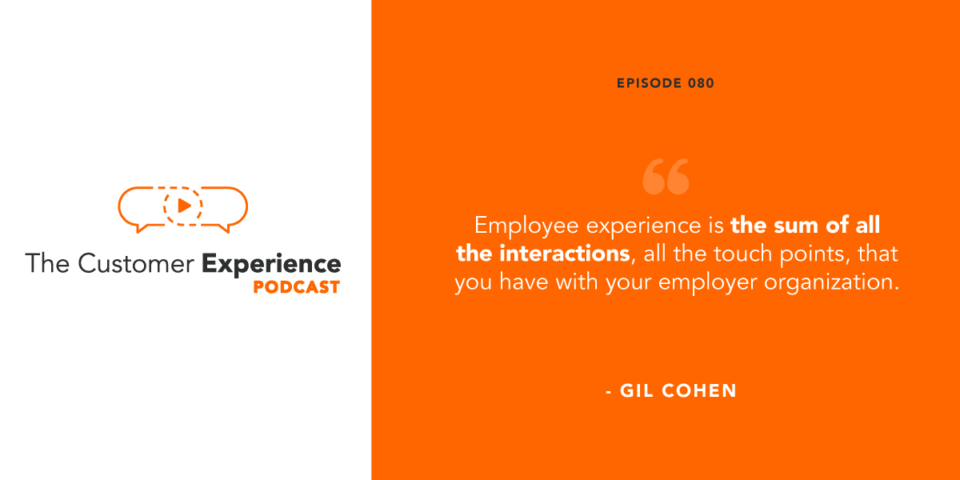
Full Transcript: Employee Experience Design – How, Why, and Where To Begin
Ethan Beute:
Making the world a better place to work through co-creating great experiences, that’s the LinkedIn headline of today’s guest. And who doesn’t want the world to be a better place to work? To get there though, we must focus on a great employee experience as a necessary precursor to a great customer experience. For more than 15 years, our guest has consulted businesses on vision, values, behavioral interviewing, succession planning, and more. He also spent two years inside an IT company focused exclusively on employee experience full-time, that motivated him to found Employee Experience Design. Gil Cohen, welcome to the Customer Experience Podcast.
Gil Cohen:
Thanks for having me. I’m really happy to be here.
Ethan Beute:
Yeah. I’m really excited about this conversation. I’m so glad we connected on this through a mutual friend and former podcast guest here on the show. And this conversation about employee experience has kind of been a background conversation through multiple episodes that we kind of like drive by a little bit. It’s been part of my developing understanding of how to create and deliver better experiences by focusing more on internal service quality.
Ethan Beute:
So I’m really excited to talk to you, who spent years focused so specifically on the employee experience. But before we get going, we’re recording this in early mid-May, 2020. You’re in Toronto. What’s going on up your way with regard to the pandemic? How’s it going, how’s it affecting you or your family or your customers or businesses in the area? What observations do you have about it right now?
Gil Cohen:
So I would say overall, right now in Ontario and in Canada, it’s being managed reasonably well. We’re just past the top of the curve when it comes to cases, but it’s still not going down completely. So I think we still have a few weeks of social distancing at minimum, if not a few months. Certainly, it’ll be a while before they really open up a lot of the restrictions. They just opened up garden stores on Monday, which was nice, which it’s great for people to be out and in the garden, something very therapeutic, very positive to be able to do, And they’re obviously taking very careful precautions as they do that.
Gil Cohen:
How has it impacted me? It completely adjusted the strategy that I thought I had at the beginning of the year when starting Employee Experience Design because a lot of the realities that it was based on in terms of my strategy, the world isn’t the same now. So I’ve had to adjust that, which is also exciting because it gives me an opportunity to innovate and see what the market is looking form and find a way to really add value in a different way, but still in alignment with my vision, which is to make the world a better place to work.
Ethan Beute:
Awesome. I appreciate your vision, I appreciate you sharing that, too, and I think your positivity and flexibility are something that a lot more people and a lot more teams and a lot more organizations are going to need as we continue to figure out what tomorrow and what next month look like for our lives and for our businesses. So let’s get into it properly Gil, customer experience. When I say customer experience, what comes to mind? What does that mean to you?
Gil Cohen:
To me, it’s the sum of all of the interactions, all of the touchpoints that a person has with a company that they purchase from. So that would be everything from the initial hearing about the organization touchpoints through the consideration and sales process. And then as I’m the customer, my overall experience, my perceptions of it. And I would also say that one thing that has been sort of increased during this pandemic would also be my customer experiences, my perception of the organization, and how they’re treating their employees. I’ve seen a lot more concerns from people of how are they responding to the pandemic? And that impacting the perceptions, the brand perceptions, of an organization.
Ethan Beute:
I love that you offered that. I just looked at a piece of research that a friend of mine and another Customer Experience Podcast guest from early on, Kurt Bartolich, shared with me. He conducted it recently with a small team and that was one of the key takeaways is that especially in the negative comments, it was they don’t care about me, they only care about profit or they don’t care about their employees, they only care about profit. And so I think you’re right on there. I guess I haven’t asked this, I don’t think, to any of my guests before, but I’ll ask you the same question with employee experience. When I say employee experience, what are your thoughts? What’s the definition? How do you think about that?
Gil Cohen:
It’s the flip side of the coin of customer experience, in reality. It is the sum of all of the interactions, all of the touchpoints, that you have with your employer organization. But because of the impact, because of the reality of how much our work lives impact our lives as a whole, I mean, eight hours a day, if we’re lucky, adds up to about 100,000 hours in our lifetime that we spend at work. So those kind of interactions, and those kind of touchpoints, make it that much more complex. Because it impacts on so many aspects of our lives, and aspects of our wellness.
Gil Cohen:
So it’s customer experience and all of those touchpoints but taken to a greater extreme because you’re living it at least eight hours a day, five days a week, for most of us, for most of your whole adult life.
Ethan Beute:
It’s so interesting, there are a couple places I want to go there. I guess I’ll start with this one, this idea of how many more touchpoints there are. So touchpoints is common language when we talk about customer experience, and of course, now, employee experience. So when I think about companies that I deal with a lot, I might visit their website a couple times a day, or a couple times a week. I might place an order like Amazon, I’m probably ordering something … These days, anyway, I’m probably ordering something maybe twice a week. So I have a regular interaction with some of these.
Ethan Beute:
But now, as employees, to your point, we essentially are living in this environment where constantly, even when we’re all working remotely, we’re constantly in touch through email, Slack, video messaging, Zoom calls, shared documents, et cetera. BombBomb, our president and one of our two co-founders, is consistently, usually twice a week, sending videos to the entire company. Like what’s going on from a business standpoint, shoutouts to employees that are kind of going above and beyond, or working through challenges.
Ethan Beute:
So I offer all those to say there are so many more touchpoints. What do you think about that dynamic? And what are the implications of that for anyone who is thinking consciously or intentionally about employee experience?
Gil Cohen:
The complicating factor is that, like you said, for any organization that we’re a customer or, or any company that we buy their services, we interact with them only so much. Whereas our organization, we’re having touchpoints all day, and sometimes outside of work hours. For me, what I’m seeing is that the single most profound touchpoint any of us have with our organization is our manager. There’s a common expression, people don’t leave companies, they leave managers. Well, that’s not true 100% of the time, it is often true, and likely at minimum, the majority of the cases is that’s what happened.
Gil Cohen:
The manager is just one touchpoint. Every email you receive, every call you receive, every research you put together, every line of code that you write, the environment in which you’re working is part of your employee experience. So because of that, you have to look at all of the different aspects of how the organization is designed because you hit on a really, really important word earlier, which was about intentionality. Because if you don’t design it intentionally, it’s still happening. If you’re not creating it intentionally, it might not necessarily go where you want it to go.
Gil Cohen:
There’s the famous philosopher, Yogi Berra, was quoted as saying, “If you don’t know where you’re going, you might not get there.” That’s a reality of employee experience, that everybody’s being impacted by it. Every day, every email they get, the type of correspondence they have, is it done through Slack? What’s being said in that correspondence? I read a survey recently that through the pandemic, 40% of managers have not asked their employees just, “How are you doing through all of this?” 40% of managers haven’t even asked in seven or eight weeks, “Hey, how are you doing?”
Gil Cohen:
What kind of experience does that create for a person? What kind of message does that create for a person? When you’re living your life under these extreme conditions, we all have increased anxiety from what it was before. We have generally increased concerns, whether it’s for ourselves, or for our family members. And these managers, all they care about is work. What message does that say, to what that manager cares about, and what the organization cares about? It’s treating you like a resource, not a human. Which is part of the problem, when you don’t create it intentionally?
Ethan Beute:
So interesting. I mean, a couple things that occurred to me is, you offered that statistic. A, I am of the mind that we should be doing one on ones with all of our team members and managers can and should be doing skip levels, to talk directly to their managers’ direct reports. A, is that not happening in these organizations? And B, what is the one on one about? How do you even start a conversation with someone? Like hey, it’s our biweekly, or weekly, or monthly conversation where we carve 30 minutes or 60 minutes out of the day to catch up on what’s going on, to provide feedback, to make sure everything’s going all right, to just get a sense of where is the culture?
Ethan Beute:
I think you wrapped that up very nicely, which is, what is someone left to feel like but a number or a resource? And there’s, at least in terms of a customer experience, one of the most annoying things is for a customer to be left to feel like a number rather than as a person or as a customer, so certainly here, as an employee. I think there’s, gosh, this is such a big and important topic. I guess I’ll go to wellness. You used wellness earlier, and I think it’s related to what you were just talking about there, is how am I left to feel?
Ethan Beute:
So talk a little bit about the importance of wellness, and how maybe that can be designed into the experience in order to make sure that our team members are in reasonably good states of mind and feel good about the work they’re doing, the people that they’re doing with. Maybe have a sense of purpose. Wellness is a big concept, but how do you think about wellness in general? And then how do you think about it specific to the employee experience, and how we can maybe facilitate it or cultivate it?
Gil Cohen:
So wellness for me, the way I conceptualize it, the way I’ve learned about it, is that there are eight main aspects that contribute to our wellness. Our financial wellness, our environmental wellness, physical, social, occupational, intellectual, spiritual, and emotional. Those are all the aspects of wellness that play on our lives and impact our lives. Ultimately, it determines both the quality of life that we lead and our behavior. It determines how we want to act. So by being intentional about this, it means looking at each of those aspects of wellness, and creating a greater understanding of, first of all, what your cohort of employees cares about.
Gil Cohen:
Because the reality is that every organization is different, every organization has different values, and has hired a different cohort, and rewarded and punished according to their own values of the leaders. So it’s really important to understand that based on your cohort, you’re going to get different wellness factors that are more important. So for me, I worked with an IT group where they, the deeply technical people, were very intent on constantly learning. If you don’t learn, you’re obsolete after six months.
Gil Cohen:
So for them, that was really a fact of their occupational and their intellectual wellness, because that’s what they were driven by. That they needed to continue in their careers, and they needed to continue to expand their mind. Whereas you take a group of nurses, where that’s not necessarily what’s going to drive a group of nurses. That will be more around the physical wellness, environmental wellness, and spiritual wellness, which talks about a person’s purpose, and the purpose of the organization in the alignment there.
Gil Cohen:
So it’s really important to start there. Start by understanding your own group of people. And then, understand how does your organization, how does your culture and experience, impact each of those factors? What are you doing as a leader to create or dismiss a person’s physical wellness? Are you making a person work 12, 15 hours a day where they don’t get enough sleep? They don’t have an opportunity to exercise? What kind of spiritual wellness are you providing for people? Are you just saying your purpose of your organization is to make money?
Gil Cohen:
Or is there something greater? Which is something that we’ve seen more recently, that millennials are demanding much greater than Gen X and Baby Boomers before them because they recognize their own spiritual wellness, and how it relates to the workplace. So it’s important to recognize that each aspect of wellness is impacted significantly by our work experience and by starting by being conscious of that, knowing what people care about, and understanding how your organization is impacting them will lead a person, an organization, on a path to be able to create the right experience.
Ethan Beute:
Really good. For folks who are listening, if you could visit BombBomb.com/podcast, it’s just B-O-M-B-B-O-M-B slash podcast, we do really concise write-ups, we do video clips, we do fully embedded audio. And I’ll list out things like those eight characteristics of wellness. So if you didn’t write those down, or you don’t want to write them down, you’re maybe listening on the move, you can go to BombBomb.com/podcast and look for this episode with Gil and you can find them all there.
Ethan Beute:
And I want to go in one step deeper on that. For folks who are listening, would you recommend that they take this list into their next one on one with some of their team members and ask them? Or would you recommend that they take an hour out of the day, and just sit down and think about their group in general, or think about some of the individuals and what they already know about them? How would someone maybe approach, from a practical standpoint, thinking about what factors of wellness, like what are the two, three, four, that matter the most? So that they could maybe start focusing on them. Take that one step deeper, and make it practical for folks.
Gil Cohen:
Absolutely. Great question. So the first thing that it starts with an understanding of your team. One of the things I’ve noticed through the pandemic is that the people and the leaders who understand their team better, and who’ve already had that sense of empathy, will have better answers of how to deal with this. Because I wouldn’t necessarily suggest as being so blunt as to walk in with eight questions saying, “Okay, how is your emotional wellness? How is this?” But sitting down, taking the time to reflect what you know about each of the individuals, and how might you ask questions that elicit these answers?
Gil Cohen:
How might you ask a question that is appropriate to that individual that will get to the heart of it? Because it’s not going to be, how’s your physical wellness? It might be something if a person’s generally a person who exercises a lot, but they go to the gym, asking them, so are you able to hit the gym these days? Obviously not, what are you doing otherwise? What are you doing and how are you taking care of yourself?
Gil Cohen:
But asking the questions also from the standpoint of curiosity and empathy of trying to understand what’s really going on with them. But I wouldn’t suggest being so blunt as to just hammer them over the head with these eight questions. It takes a little bit of nuance, and it takes understanding of the individual, to know how to ask that question that you’re going to get an honest answer. Because I’ve also seen numerous articles where plenty of employees feel the pressure to just say, “Fine.” Right now. Because they don’t want to tell their employer things are difficult because people are worried about their jobs. Which goes to financial wellness, which is about job stability.
Gil Cohen:
So if people don’t feel their job is stable right now, they’re not as likely to share with their manager what’s really going on. So it’ll take a little bit of digging, and a little bit of genuine curiosity to get to the heart of it.
Ethan Beute:
Yeah, and actually caring about the other person. So listening to you talk, I just think, gosh, it seems like just being a truly decent person would probably make you a pretty good manager, and probably set up a good culture, at least within your part of the organization.
Gil Cohen:
I do want to be empathetic with managers that aren’t doing this to not dismiss them as not being good people. Because oftentimes, we behave based on what we expect the outcome to be, or what we’ve learned. So the traditional arm of leadership was, I’ll tell you how to do things, and managers need to know everything. Well, that doesn’t change over 25, 50, 75 years. It changes over a very extended period of time. So if you look at how management was, and it wasn’t even HR back then, it was just personnel, back in the ’40s and ’50s, and how people were treated, you were lucky to have a job, and they could treat you however they wanted and you were there for 25 years, right?
Gil Cohen:
And now, we know that that is no longer the reality of the society that we live in. But I just, going back to it, though, I don’t want to dismiss managers that aren’t doing these things. I want to help them understand that if they add this to their toolkit, they will be more effective, and their people will be more effective.
Ethan Beute:
Yeah, thank you so much for that correction there. At least I’m on my bias, I’ve been working in a very healthy culture and healthy environment for the past eight and a half years, where I feel like people see me for who I am as an individual, I get positive feedback and corrective feedback on the work that I do, we have consistent meetings. It’s so funny, gosh, what a horrible bias for me to reveal in this conversation.
Gil Cohen:
Not horrible. I think it’s a reality. I think, first of all, we all have biases, and that’s just a fundamental aspect of being human and the heuristics in our brain, and I understand that. But it’s also a lucky bias to have because look, it’s because you’ve been living the right way for the last few years, that you have people bringing you feedback that’s not personal but performance-based, but behavior-based, right? That you have effective communication, two-way communication with people, that sometimes we end up in our own little bubble of oh yeah, I forget how horrible some managers are. They’re not trying to be horrible, they just think that’s the right way to be a manger, that’s how they were trained. That’s how their successful boss did it, so, therefore, they’re going to do it as well.
Ethan Beute:
Yeah, it’s really interesting. I guess, let’s go into that a little bit. To your point much earlier, and I say the same thing about customer experience when I talk about it, it’s always happening, it’s happening whether you know it or not. It’s happening whether you think about it or not. I guess, answer this in two ways. One, how important is it for an organization to start getting intentional about employee experience? And second layer, what are some places people would start?
Ethan Beute:
If they’ve just been kind of, you know, we’ve got our HR department, and everything seems to be going okay, and the business seems to be doing okay, despite some of the economic hardships of the climate, whatever, why should leaders in that organization care about employee experience? And what are some of the initial steps, maybe, if you were going in on a consultative basis, where would you start thinking about, and starting to move the organization toward a more intentional employee experience?
Gil Cohen:
So the why, why you should care, is really about the bottom line. Why you should care is, if you take it through the whole five why’s exercise of why is employee experience important? Because it drives human experience. Why is human experience important? Because it drives human wellness. Why is human wellness important? Well, there’s two answers to that, depending on your values, that you’ll value one way or the other. Either human wellness is important because it impacts our quality of life, or the other side of it is, why is human wellness important? Because it impacts our behavior.
Gil Cohen:
Why are our behaviors important? Because they determine the bottom line, they determine business outcome. So your people’s behavior are impacting your bottom line and your outcomes. If you intentionally design those behaviors and work toward an effective creation of an environment that facilitates those behaviors, you will be more effective at achieving your outcomes, as well as creating a better quality of life for your people. So depending on which one you value, either of those would be a good reason to do it.
Gil Cohen:
Then, you asked me, on the how to start? So my belief, I feel very strongly that employee experience is an evolution, not a revolution. Because a lot of leaders are used to thinking a different way, and it’s not so easy as to just tell people yes, you’ve been successful to this point, but you can be much more successful if you change X, Y, and Zed. It doesn’t come so easily, you’re a leader, you know that, right?
Gil Cohen:
However, if you demonstrate the value in small pieces, by finding pilot projects where you’re able to find a group, empathize with them, find one of their problems, and design an experience, design their experience, to improve upon that, that’s going to be different for every organization of where their pain points are. You know, before the pandemic, I would say a lot of organizations would have been wise to do that with their candidate experience, and they might want to still consider that before they’re going to be ramping up hiring again. Because candidate experience is so key to onboarding people and effectively welcoming people and inviting people into the organization.
Gil Cohen:
But it depends on the organization. One area I often recommend for people is through the sales organization. Because one, often the sales organization is broken. That’s just the reality, that it isn’t taking into account employee experience, it’s taking into account outcomes always and what you want people to accomplish and not the experience of, that you’re creating to get people to accomplish those outcomes.
Gil Cohen:
As well, the one great thing about a sales team is that you can demonstrate the impact. There are clear and tangible outcomes for certain changes in experience. I’ll give you a great example. I was talking to a sales leader a couple of weeks ago, where one thing that he did to improve his employees’ experience was when they were onboarding, they previously had a full quota of 40k. But for their first month, they gave them a quota of 10k, second month they gave them a quota of 20k, and then ramping up. He said, “Forget the quota for months one and two.”
Gil Cohen:
Then all of a sudden, their sales reps went from making about 9, 10k in their first month to making 20, 30k in their first month, because they were freed from this quota, from having to think about the quota. So a simple, little aspect of experience of that number had such a profound impact on people that it was actually limiting them. And that is a key point about designing intentionally, for those leaders who question why we should design intentionally, that’s a great example of it.
Gil Cohen:
Because if you don’t, you’re putting your thumb down on the entire organization, and you’re limiting everyone’s capability.
Ethan Beute:
Really, it’s such a function of expectation, and that was the thing that I thought, in liberating them from, I guess, essentially like a price anchor, it’s 10, I’ve got to hit 10. So we’ll pace ourselves to 10 or something. So you open it up and support people, and just see how far they can go, what they can do, et cetera.
Gil Cohen:
Totally.
Ethan Beute:
I love your recommendation and the kind of dual-layer reasons, to start in the sales organization. I think it makes a lot of sense. But you also drove by something that’s very interesting as well, that I think is really worth talking about, at least for a couple minutes. Which is, the customer experience starts when the customer, there are so many different places or different ways for it to start. But it essentially starts with some layer of, I come across you, a friend mentions you, I wind up on your website. Or some of these early investigative pieces.
Ethan Beute:
And they start to affect the way we … We’re starting to put together expectations about what this company is like, what are they about? How might their products or services be for me? Et cetera, et cetera. I start developing these expectations. This all starts for the employee, with the hiring process. So maybe, share a couple ideas about the impact of the initial touchpoints. Again, in a hiring scenario, only one of the candidates, let’s just assume you do second, third interviews with five candidates, let’s say, but it started with 50 or 100.
Ethan Beute:
Most of them aren’t going to get hired. How do we think about all those people that don’t get hired but are still potential hires? And are going to carry into their, through word of mouth, their communities, what we are like to potentially work with and work for. Talk about some of those dynamics around recruiting, hiring, all the precursors to the onboarding experience.
Gil Cohen:
Absolutely. So first thing I will say is that the employee experience actually starts before the hiring process. It starts with employer branding. It starts with, what are our perceptions? It’s very similar to the customer experience of I hear about these people, I either end up on their website, somebody tells me about them. But not in the context of what it’s like to buy from them, but what it’s like to work from them. That’s why over the last 5, 10 years, employer branding and organizations has grown significantly because people have recognized how important it is to sell what you’re like internally to the candidate market.
Gil Cohen:
So that is actually, in the employer brand is actually where they start the employee experience because even though it’s passive, it does start there. So you ask a great point because you’re right, there will be 50, 100 people who start in a hiring process, and it gets whittled down, only one, maybe two of them are getting hired. But how do you consider the candidate experience for all of them?
Gil Cohen:
The first reality, just by thinking about that helps. Because by starting to think about the experience from the other person’s point of view, you’ll make decisions in alignment with their expectations. Because expectations, I’m so happy you hit that point, expectations is a fundamental lens through which all experience is interpreted. So every piece of employee experience goes through that expectation lens, which is why two people can have literally the exact same experience and one person can be miserable, and one person can be elatedly happy, because of that expectation lens.
Gil Cohen:
So by starting with the candidate experience, with candidate experience is the first part of onboarding. It’s the first time where the organization can really demonstrate its willingness to live up to those expectations, and actively set realistic expectations. So that is such an important part of just recognizing that. The other part of it is flipping your lens when making decisions about the hiring process. Because one of the difficulties that I found with many organizations to get to that candidate experience is everything goes through the organizational lens.
Gil Cohen:
Even by just talking about it, just as the contact position or hiring process, well that’s what the organization’s thinking about it. But that candidate, they’re looking for a job. That’s what their part on that dynamic, on that dimension is going. Is they’re just looking for a job. So how do we align our process with what that person is going through? So an example from when I was working on my IT company, that we realized, was that when you bring somebody in for an interview, and I know it’s not common now.
Gil Cohen:
But when you bring somebody in for an interview who’s looking for a job who already has a job, often, they’re under pressure to dress in a certain way, because we’re all expected to dress in a certain way for an interview. But that might be different than what their culture dresses like at their current organization. So by asking them to dress in a suit or anything like that, or dress up, you might be putting them at risk in their own organization.
Gil Cohen:
When we recognize that, I was the one who was calling them in. I said, “Hey, look, you’ve got a job right now, we don’t want to put that at risk, we respect that because you may or may not be a fit for this role, like you may have to continue working there. Dress as you normally would.” And the feedback I got from that was amazing. Because people recognized, okay, we cared about what they were going through. It wasn’t just what the organization was trying to get out of the experience. But there’s two parties.
Gil Cohen:
Just by acknowledging the other party and what they care about, there’s a newer word that I learned a few years back, it’s become one of my favorite words, which is sonder. Which is the idea that the recognition that every other person who we walk by has inner working, and an inner life, that’s as complex and dynamic as our own, they have their own hopes and dreams, and that’s true for every person we walk by. Every time we drive, and there’s a light on in the window, there’s a story there.
Gil Cohen:
So by the recognition that the organization isn’t the protagonist of the story, but that everybody’s the protagonist of their own story, and by including that into your decision-making lens, you’re able to create an experience that flows more effectively, that even when you’re told, “No.” At the end, you appreciate it. I’ve known people that have been raving fans of organizations that have been denied from working there, because they appreciated the way they were treated, and they understood why they didn’t get a job there.
Gil Cohen:
So it’s so powerful when you can have raving fans from the ones who didn’t get it by just caring. And it goes back again, by just caring. By caring about what the other person is going through, and then making decisions accordingly so that there’s overlap, as opposed to just making decisions … This is what the organization wants, so we’re going to put you through seven layers of interviews. Some of them will have 10 people in an interview. We’re going to ask you to do two weeks of free prospecting for us. And then we’re going to wonder why you have no interest in our hiring process.
Ethan Beute:
Right? I really appreciate this idea of recognizing each person as the hero of their own story. And the organization in this scenario coming alongside and operating a little bit in a spirit of service and empowerment, which reminds me a little bit of the way you talked about bringing this into a sales organization. But just that intentionality, setting expectations, being clear, taking mystery off the table. Anyway, there’s so many really important themes there. I’m going to go really high level with you, Gil, the paradigm of organization as experience. What got you turned onto that in the first place? How have you wound up down this road in general?
Gil Cohen:
So back in 2016, 2017, I had been working for a consultant more in the talent management, and peripherally in employee experience for years just not calling it employee experience. But I had lost my passion for it over time. I had been doing it for a number of years, so I just had lost my passion. But I reinvigorated my passion by learning about the employee experience lens, and by adding the employee’s perspective to the leadership decision making process. People have been doing it for years. In some forms. It’s just not common enough, it’s not popular enough, and it’s not recognized in its value enough.
Gil Cohen:
The thing that really kind of set me back in my chair, so to speak, was in 2017, I watched on LinkedIn, there was a video of a US designer speaking at an event, talking about how essentially everything in life is user experience. The example, he started talking about the chair, different chairs, depending on how they’re designed, what’s it like standing up from it? What’s the comfort level while you’re in it? Is it going to encourage sleep? Is it going to encourage productivity? Different aspects of just a chair that everybody’s sitting in.
Gil Cohen:
For me, it then dawned on me, it’s like, okay, so if everything in life is user experience, there’s no more single profound user experience on our lives than our work. As I said before, if we’re spending 100,000 hours of our lives conservatively at work, well, that is a very impactful experience in a way that no experience that we’re a customer of holds a candle to.
Gil Cohen:
So for me, I started just to make the connection between the experience people have at work, the lives they lead, because if you’re having to work 12 hour days, or if you’re working eight hours a day but you’re miserable and you don’t want to talk to anybody at the end of the day. Or you’re too stressed to feel that you want to exercise at the end of the day, or you’re losing sleep at night as a result of this, or you’re having so-called Smondays, which is that feeling at 2:00, 3:00 o’clock on Sunday afternoon when you’re so stressed about the week coming up that you lose the rest of your Sunday.
Gil Cohen:
These are the kind of things that drive me that need change, because if we’re able to change these things in our work lives, it impacts our overall lives, and it impacts the business. Like I said, it’s not just the cliché of happy people are productive. But if we serve their wellness, it will elicit behaviors that serve the organization as well. If I’m worried about my job, my occupational wellness, I’m going to hoard information because hey, if nobody else knows it, they can’t fire me. But if the organization rewards me for sharing that information, then I’m going to share that information. And they’re going to provide me feedback and positive outcomes because I shared that information, well that’s what’s going to happen.
Gil Cohen:
Leaders all over the place complain that their people don’t share information and they’re not hearing anything, the iceberg of ignorance is real. But they’re the ones that have created it. Their behaviors, and experience created for their people, have led to the outcomes that they’re experiencing.
Ethan Beute:
I love it. It’s a noble mission. I have 50 more questions, but I guess I’m going to have to save them for another conversation. This has been fantastic, and if you’re listening along here, and you’ve enjoyed this so far, I’ve got a couple other episodes that are in a similar vein, pretty recently, episode 73 with Chris Wallace of the interview group Marketing To Your Employees, Not Just Your Customers. So it’s internal marketing. He thinks about it a little bit differently than we kind of brushed by here, in this conversation. But that’s episode 73.
Ethan Beute:
Then back on episode 39, with Lance Risser and Levi Iris from Dutch Bros Coffee, a company that serves a whole bunch of the western United States, and has just this raving fan base. So many of their employees started as raving customers, raving fans, that episode’s called Company Culture as Your Competitive Edge, again, that’s episode 39. I guess, last question before I ask you a couple of my favorite questions of the conversation, what do you think about the relationship between culture and employee experience? In my mind, as you were talking, I was thinking a little bit as kind of culture as how we do it around here, what are the norms? What are the expectations?
Ethan Beute:
We, at BombBomb, do an annual culture survey and wind up producing an employee NPS to kind of keep a litmus of how are we doing overall? And we look at that overall in aggregate and by department. And have follow-up conversations with the managers of some of those teams and with each of the individual employees, not about their survey feedback, it’s all anonymous. But what we heard, and what we want to do and that kind of a thing. So we’ve used language around this. So I think we’re doing some things well.
Ethan Beute:
To you, how do you know you’re doing it well, and what’s the relationship between culture and employee experience?
Gil Cohen:
So culture is one factor within employee experience. There’s different ways people …
Ethan Beute:
Oh man, that’s a whole nother conversation. Good, I’m sorry, I’m sorry.
Gil Cohen:
Employee experience … It is. There’s different ways people cut employee experience. A very popular way is environment, technology, and culture. Those are the three main ways. I look at the nuance a little bit differently than that. But generally, culture is an aspect of the experience. The way things are done around here. I’m always wary with culture, because it means different things to different people, and very often, in organizations that I’ve worked with, leadership teams use culture as a reason to not do things but to pass it off to the talent leader or the HR leader.
Gil Cohen:
So the leaders of the marketing and the finance groups and the operations groups don’t think that culture is actually their responsibility when they are unbelievably important when it comes to building, sustaining the right culture for your organization. So culture, it’s kind of a fuzzy area. But it is a fundamental aspect. Because if you want to define it easily, as the way we do things around here, well, you can start to break that down into very real aspect of employee experience, of how it impacts people.
Gil Cohen:
The way we do things around here, are you talking about decision making? Is everything consensus? Is everything just the highest-paid person in the room makes every decision? What do you mean by how we do things around here? Do we welcome feedback? Right? You work in a culture where your people are open to feedback, people give constructive feedback. But in an organization where leaders aren’t open to it and don’t welcome it, especially the founders, then it’s not going to be a culture of feedback, it’s not going to create that.
Gil Cohen:
But culture is something that I shy away from the lens often because everybody applies their own values and their own judgment to it, and I try to talk about aspects of culture that are more tangible, so everybody’s talking on the same page, talking about behavior, talking about the decision-making process, talking about rewards, talking about rituals, language, those kind of things by making it more real, as opposed to talking about culture, then everybody just applies whatever they want to their lens.
Ethan Beute:
So good. Consider that, if you’re listening, consider that a preview of my next conversation with Gil here, on the Customer Experience podcast. We’ve got to wind this one down, and in doing so, I’d love to give you the opportunity to thank or mention someone who’s had a positive impact on your life or your career, and to give a shoutout or a nod to a company that you respect for the way they deliver for you, as a customer.
Gil Cohen:
So for in terms of the customer experience, a customer experience that I’ve appreciated more recently, I’m not a customer, but my wife is, there’s a company here in Canada called Zoomer, which their target market is anybody 45 and older. They’re targeting with cell phone plans, among other things. So my wife and my mother in law have recently joined their cell phone plans because they’re targeting people who aren’t looking for complexity, aren’t looking for the latest and greatest.
Gil Cohen:
So the simplicity of their plans, the relatively low price, the honesty of their people, so these plans come with a phone, that when I forget who it was, called them and said, “Okay, but I don’t necessarily need the phone.” The person’s like, “Okay, most people sell it on Kijiji anyway.” They were honest with this is how it is, this is who we are. So I appreciated that.
Gil Cohen:
But much more importantly, the person who I would want to give a shoutout, or thank, is really my father. I worked for him as a consultant for the first 16, 17 years of my career, I was learning from him before that. Without him, I wouldn’t know 100th of what I know, I wouldn’t have a 100th of the experience that I have. I’m so grateful that he took the time to coach me, teach me, saw something in me that I never saw in myself. And so he’s definitely the one person who I am very, very grateful for, and he’s the one person who deserves to be mentioned in this case.
Ethan Beute:
Awesome. He sounds like a very good human. Gil, this has been an absolute pleasure. I really appreciate the work that you’re doing, and I completely buy your premise that if we can create better experiences for employees in more places, that we’ll just have healthier people walking around among us, working with us, befriending us, serving us, et cetera. So thanks for what you do. If people want to follow up on this, what are some ways that people can connect with you or with Employee Experience Design?
Gil Cohen:
So there’s two main ways. One is I’m on LinkedIn, search Gil Cohen, there’s only so many of us out there. And the other way is through my website, www.employeeexperience.ca.
Ethan Beute:
Awesome. I will, again, link those up in the write-up on this episode at BombBomb.com/podcast. Gil, thank you so much for your time. Thanks for the work that you do. And to you, thank you so much for listening to the Customer Experience Podcast.
Gil Cohen:
Thanks for having me.
Video Highlights: Employee Experience Design – How, Why, and Where To Begin
Check out the top five video highlights from the discussion with Gil below…
1. Employee Experience Defined
2. Eight Types of Wellness
3. Why to Invest in the Employee Experience
4. Why to Start an Employee Experience Initiative In Sales
5. Company “Culture” Considerations
Other Episodes You’ll Enjoy:
- “Marketing to Your Employees, Not Just Your Customers” with Chris Wallace (Co-founder and President at InnerView Group)
- “Company Culture as Your Competitive Edge” with Lance Risser (VP of Southwest Field Operations, Dutch Bros Coffee) and Levi Ayriss (VP of Northwest Field Operations, Dutch Bros Coffee)
- “Mental Health in Sales: More Than 40% Struggle” with Jeff Riseley (Founder, Sales Health Alliance)
Please Subscribe To, Rate, and Review The Customer Experience Podcast:
